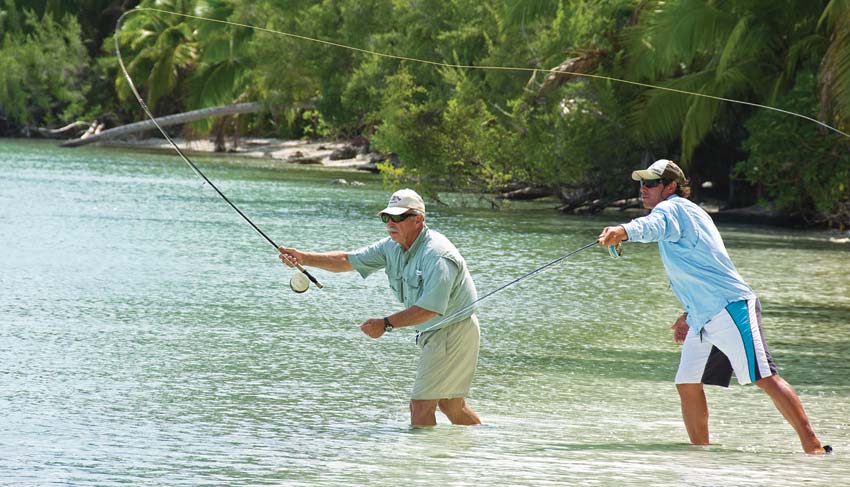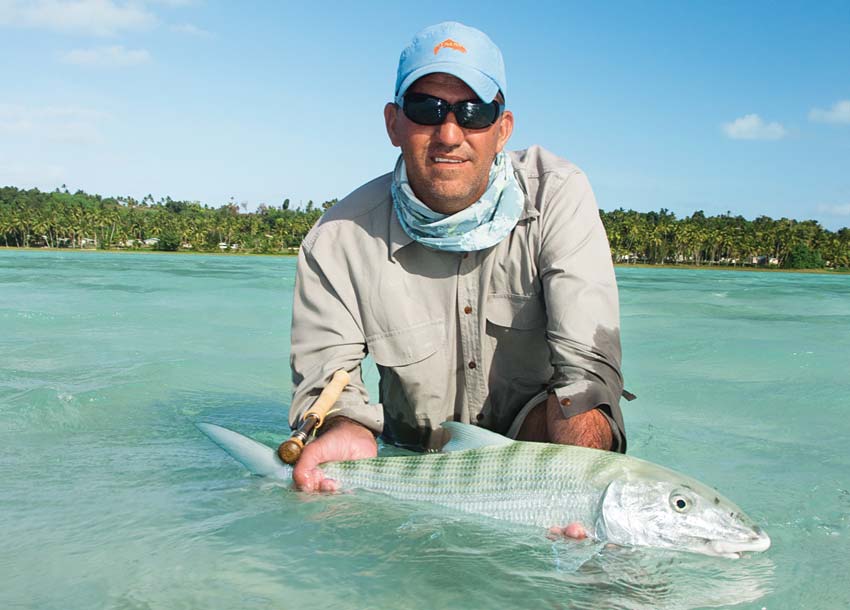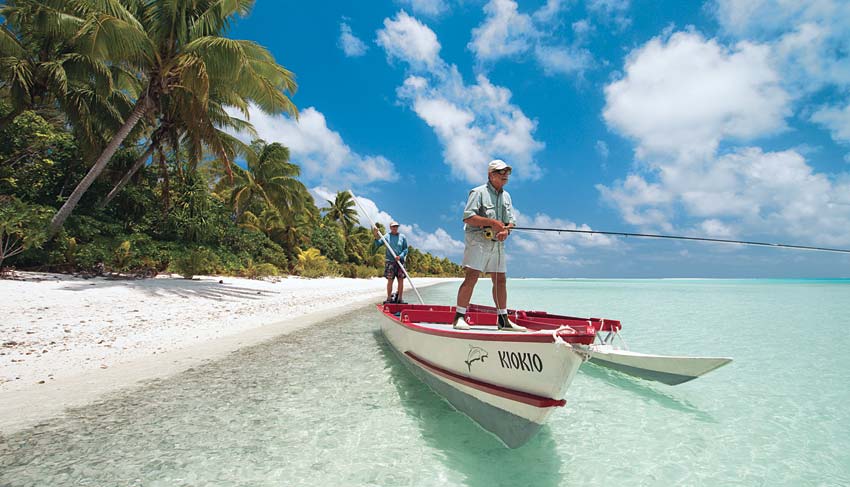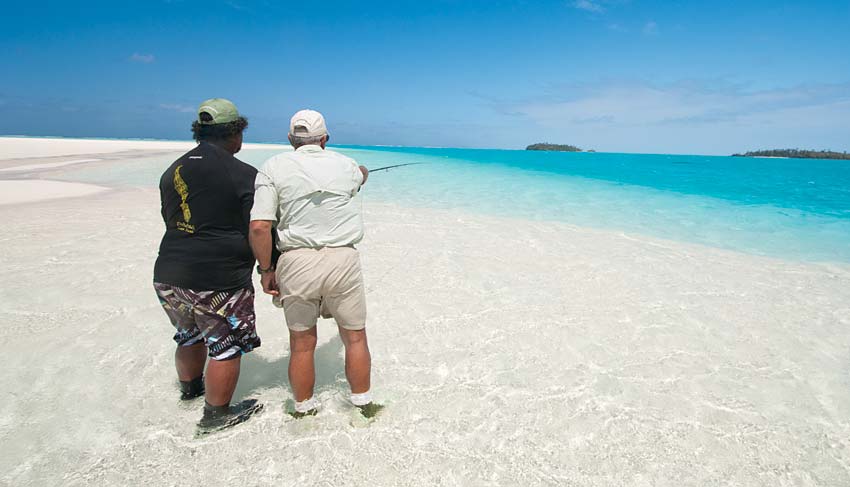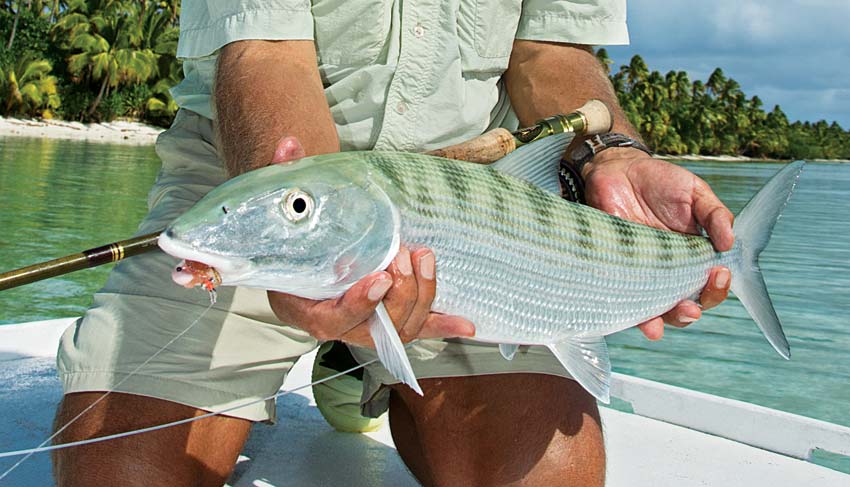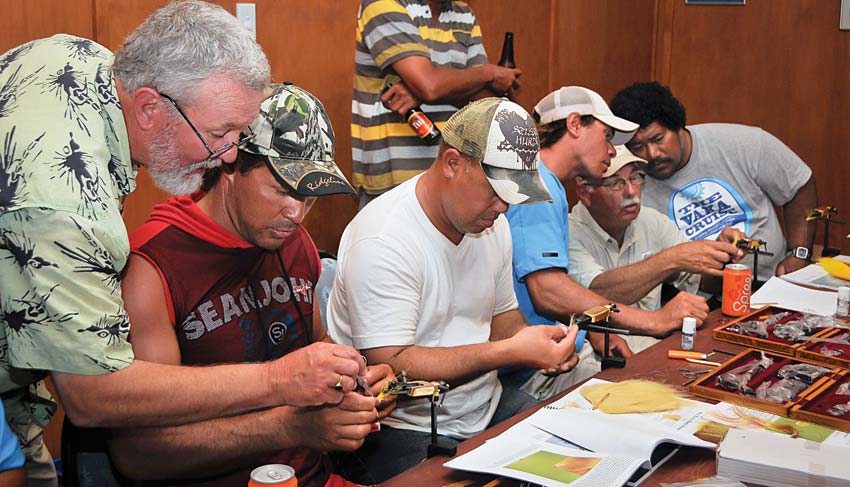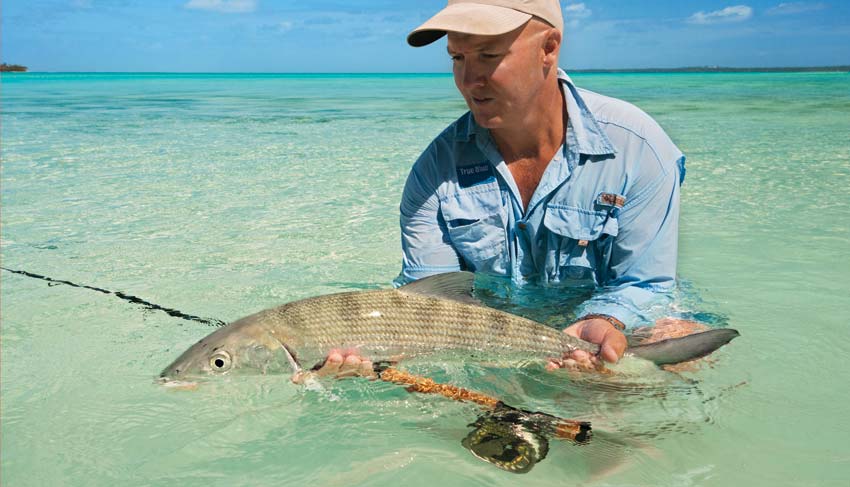
Scudding clouds driven by 25-knot winds plagued the shallow flats as whitecaps rippled across the surface, affording only glimpses of the coral-strewn bottom. I was wading the flats of the Aitutaki atoll, in the Cook Islands, with Ian Dollery, director of the Aitutaki Bonefish Management Committee. After hours of intently looking for the vague signs of bonefish, I noticed my attention beginning to wane. We had seen only fleeting shapes as the bones had bolted, undetected until it was too late to make a presentation. I mentioned to Dollery that this was the time of day when anglers need to be diligent, and then it happened — out of nowhere, a huge form materialized in front of me, confusing my senses with its impossibly large proportions. I’ve presented flies to some very large bonefish in the Florida Keys and on the Bahamian flats of South Andros, but this bonefish froze me in my tracks. The sudden appearance of the fish, coupled with the fact that it was just six feet away, allowed time for only a quick roll cast that landed a bit long and left of the target.
As I stripped the Gotcha into its path, the bonefish rushed to inspect the fly. I let it drop to the bottom, and the bone took a quick look and started to move away. With a short strip, I attracted the fish’s attention again, and it tailed and ate. I set the hook, but the fish didn’t respond. When it realized that this was more than a crab’s pincer, it beelined across the flat and into a nearby minefield of coral heads. Dollery and I high-stepped in the shallow water, and I loosened my drag to better my odds. We managed to navigate around several submerged boulders before the backing seemed to disappear under a single head. As Dollery reached down to untangle the line, it parted, leaving only the ragged edge of the backing.
I had been humbled by one of the enormous bonefish of Aitutaki, fish that grow to legendary proportions. In under a minute, that fish, which Dollery estimated between 14 and 16 pounds, relieved me of my fly, leader, line and about 50 yards of backing. The experience made a definite impression on me, as similar ones have on other trophy-seeking anglers who’ve stopped here. Fortunately, I had a few more days to redeem my wounded ego.
I was visiting the atoll with Will Bauer, noted permit angler. Bauer was scouting this location for The Fly Shop, in Redding, California. With us were Brett Wolf and Peter Morse, two of Australia’s most respected fly-fishing authorities. We had been invited to the Cook Islands to experience the opportunities for catching world-class bonefish and to get the word out to the world’s angling community. We were hosted by Alan and Maria Mills, owners of Popoara Ocean Breeze Villas, who provided us with terrific accommodations and space at their Boat Shed Bar and Grill, where we worked with aspiring guides to teach them fly tying, casting skills and even knot tying. We arrived with gear provided by Loop Tackle, Far Bank Enterprises, Maui Jim, Shimano Australia and The Fly Shop, all of which were incredibly generous in their support. Dollery had advised us to bring tackle that was up to the challenge of the area’s remarkable bonefish.
I brought three outfits: a 9-weight, a 10-weight and an 11-weight. It didn’t take long for me to find out that even the stoutest fly tackle could be defeated by some of the monster bones of Aitutaki. Most of the effective flies were McVay Gotchas or variations of Clousers with large medium-weight lead eyes. The lees of some of the atoll’s islands, like Akamai and Long Island, provided calm water where the big cruising bones could be very selective. The largest bonefish of Aitutaki are extremely wary and require long, accurate casts and double-digit leads.
Aitutaki’s first guide, Itu Davey, occasionally has days with 15 bones and coaches his anglers to place their flies up to 12 feet in front of a cruising fish. When the bonefish spots the fly, let it drop to the bottom. It takes a lot of patience and willpower to leave a fly perfectly still when a big one swims over to inspect it. Keep it still and only move it if the fish loses interest. A smooth strip will often get you the second chance that’s needed.
On one of the many blustery days during our trip, I fished with Butch Leone, an American who has been fishing Aitutaki for over 18 years. Leone was one of the early champions of controlling netting and showing the locals the viability of a bonefish guide fishery. Despite the conditions, we persisted working our way up the lagoon. As we waded the shallows during the beginning of a falling tide, we both knew the warm water flowing across the flat was a good sign. Bonefish began working up on the white sand adjacent to a distinct blue-water edge. It was one of those frustrating days when just as a bonefish would come into view, a cloud would obscure the flat, and as it passed, so did the bonefish.
Finally, as the sun made its way from one bank of clouds to another, two double-digit bonefish swam into view. I made a cast and stripped to attract them, but yet another cloud hindered my view. Out of options, I continued to strip until I was connected to a fish that took line from my reel faster than any other I’ve hooked. The bonefish took an honest hundred yards of backing so fast I could only watch in awe. Unfortunately, this fish had a Ph.D. in structural analysis and headed for one of only two coral heads in sight. My second tango with a double-digit fish on the trip ended just as my first had. Despite the disappointment of two trophies lost, there were some excellent days with lots of quality shots at big bonefish.
Bauer and I had one of those good days aboard Davey’s boat. With limited resources, Davey had crafted a reliable guide boat that he’s able to pole around the flats. He managed to get us into casting distance of a number of single fish and even a handful of small schools. Both Bauer and I landed plenty of fish that afternoon. During our stay, the weather was challenging, with brief periods of full sun; however, several double-digit fish were landed. That bodes well for the action here when conditions are better.
Aitutaki and the Cook Islands’ Ministry of Marine Resources are focused on developing a guide-based fly-fishing industry for bones. It is hoped that through the shift from netting to sport fishing, the people of these islands can ensure that this incredible resource continues to sustain the people of the atoll, as it has for generations, while providing outstanding bonefishing for anglers.
As fly-anglers, the concept of catch-and-release is almost embedded in our DNA. The fishermen on Aitutaki have harvested bonefish in their lagoon as a part of their culture for generations. This has involved the combined efforts of the whole community and given them a sustaining food source. But the ancient tradition of gathering fish by encircling schools while holding palm fronds and then spearing them had given way to inexpensive and overly efficient monofilament gill nets.
The reality of an unsustainable net fishery resulted in the development of a bonefish management plan, the goal of which is to manage netting and explore ways to assure the fishery contributes to the well-being of the people, their families and future generations. This plan was first initiated in 2009 through the cooperative efforts of the Aitutaki Business Association, the Aitutaki Bonefish Management Committee, the MMR and the Island Council. While the plan’s stakeholders are aware that the size of the lagoon and the logistical difficulties inherent in Aitutaki’s remote location will limit the number of working guides, they are confident of the mission’s value. Committee director Ian Dollery and his staff are looking at establishing other fisheries to increase the number of potential guiding opportunities. The Island Council selected a small number of residents to receive accreditation as bonefish guides. This allows them to operate within the new laws put in place to manage the local bonefish population and assures they have the training and skills that international anglers expect from professional guides.
When the MMR began this program, it enlisted Itu Davey, the atoll’s most skilled netter. Davey was born and raised on Aitutaki and learned to net bonefish from his father, Richard. Itu said that when the MMR approached him and the Island Council, his father spoke in favor of a management plan. He saw that if Itu’s sons and the future generations of Daveys were to benefit from the bonefish resource, they would have to embrace the idea of conservation. He got the attention of local fishermen when he told them, “We can make more money by guiding than from selling fish. For me it’s about looking to the future and ensuring sustainability for the whole of Aitutaki.” Itu became the first official bonefish guide from Aitutaki and is currently teaching his own children to catch and release the fish.
The people of Aitutaki rolled out the red carpet for us and gave us a wonderful taste of the hospitality and culture that makes this South Pacific atoll a favorite destination of adventure-seeking travelers. In our honor, the locals held a celebration at which we were entertained by traditional dancers, musicians and fire dancers. We also had the pleasure of meeting Henry Puna, the prime minister of the Cook Islands, who hails from Aitutaki, and atoll mayor John Baxter. During our stay, Ben Ponia, secretary for the MMR, and Richard Story, Aitutaki Marine Research Centre station manager, provided invaluable support with staff and boats. In addition to Popoara Ocean Breeze Villas, where we stayed, there are several accommodations options, with spots for the budget minded and the most demanding travelers. There are also numerous recreational opportunities, including lagoon tours in glass-bottom boats, snorkeling, kayaking, diving, offshore big-game fishing, kiteboarding and much more.
Hopefully the people of Aitutaki will be able to fully realize the potential of their fabulous bonefishing. While this will always be a quality over quantity destination, it’s a place where the possibility of a world-record bonefish lurks on the edge of every flat and where a fisherman and his family can find a true paradise. We were captivated by Aitutaki, its huge bonefish and the amazing scenery, but it is the people, their eagerness to learn and their warmth and hospitality that will be most prominent in our memories.
TRIP PLANNER
Rods: By and large, 9-weights are ideal, but on days when the wind is strong, 10-weights are a better option. For trevally, the use of 10- to 12-weights is recommended.
Reels: Employ high-quality saltwater fly reels with a capacity of at least 250 to 300 yards of 20- to 30-pound backing. The drags need to be sufficient to stop large, powerful fish from reaching cover and smooth enough to cope with the beasts’ long, fast runs in open water.
Lines: Floating lines with intermediate tips work very well for bonefish. They allow a fly to get down deep and keep the main body of the line out of bottom structure. For trevally, floating lines are best.
Flies: McVay Gotchas and Clouser-type patterns are go-tos. Medium-weight lead eyes on size 1 or 2 hooks are used most commonly. Colors should vary, depending on the bottom. On calm days and in the lees of islands, anglers often use lighter flies with bead-chain eyes for spooky fish.
Anglers traveling from the United States can fly direct from Los Angeles to Rarotonga, in the Cook Islands, aboard Air New Zealand. The flight from Rarotonga to Aitutaki takes 40 minutes with Air Rarotonga. From the landing site in Aitutaki, all of the accommodations on the atoll are 10 minutes away. We stayed at Popoara Ocean Breeze Villas, which was close to the fishing and had comfortable rooms adjacent to food and drink.
For anglers wanting upscale lodging and a plethora of recreational opportunities for family members, the Aitutaki Lagoon Resort and the Pacific Resort Aitutaki cater to the most discriminating clients.
Island Resources
Air New Zealand
www.airnewzealand.com
Air Rarotonga
www.airraro.com
Popoara Ocean Breeze Villas
www.ck/aitutaki/popoara/index.htm
Aitutaki Lagoon Resort
www.aitutakilagoonresort.com
Pacific Resort Aitutaki
www.pacificresort.com
Itu Davey
e2davey@aitutaki.net.ck
www.e2sway.com
Butch Leone
flyfish@aitutaki.net.ck
www.aitutakibluelagoonflyfish.com

